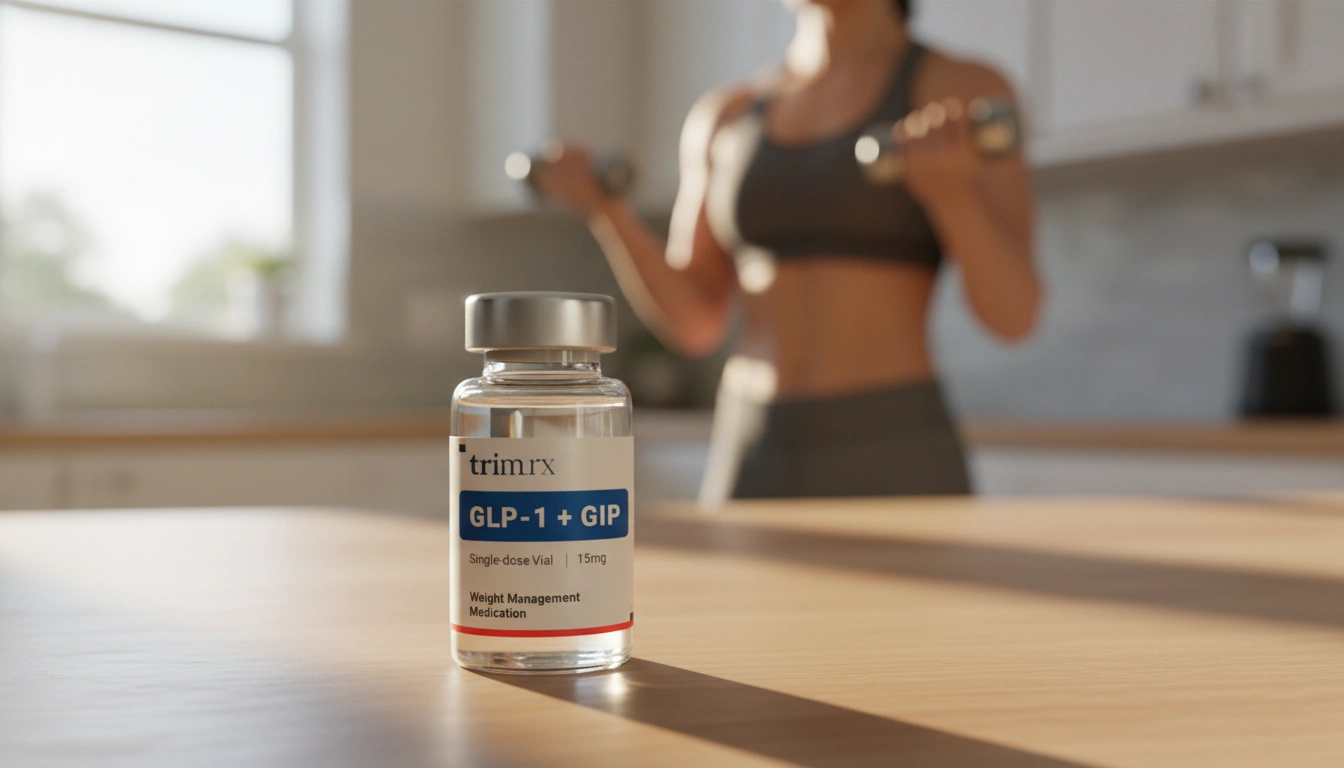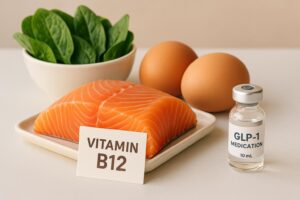What Produces GLP-1 Naturally? Exploring the Science Behind This Essential Hormone

When it comes to understanding our bodies and how they regulate appetite and metabolism, few topics are as intriguing as glucagon-like peptide-1 (GLP-1). This hormone plays a pivotal role in managing our hunger and blood sugar levels, yet many people remain unaware of its existence and importance until they hear about it in relation to weight loss medications. What if we told you that your diet and lifestyle choices could naturally enhance your body’s production of GLP-1?
At TrimRx, we believe that understanding how our bodies function is the first step toward achieving sustainable health and wellness. In this blog post, we aim to unravel the mysteries of GLP-1, exploring what produces it naturally, how it affects our weight, and how we can optimize its levels for better health outcomes.
Introduction
Did you know that the trillions of microorganisms residing in your gut play a crucial role in your metabolism? Recent studies have shown that these gut bacteria can significantly influence the production of hormones like GLP-1, which is essential for appetite regulation and metabolic health. In a world increasingly focused on gut health and dietary choices, understanding what influences GLP-1 production can empower us to make better lifestyle decisions.
This blog post will guide you through the intricate relationship between GLP-1 and our diet, shedding light on what produces GLP-1 naturally. By the end of this post, you will have a comprehensive understanding of how to enhance GLP-1 levels through dietary choices, lifestyle changes, and the importance of gut health.
We’ll cover the following aspects:
- The role of GLP-1 in our bodies
- How GLP-1 is produced naturally
- Dietary sources and lifestyle habits that boost GLP-1 production
- The connection between gut microbiota and GLP-1
- Practical tips to optimize your GLP-1 levels
Let’s dive into this fascinating topic together!
Understanding GLP-1: The Hormone Behind Appetite and Metabolism
GLP-1 is a hormone produced in the gut in response to food intake. It is classified as an incretin hormone, meaning it stimulates insulin secretion in response to meals, helping to lower blood glucose levels. Here are some of the key functions of GLP-1:
- Stimulates Insulin Release: After we eat, GLP-1 triggers the pancreas to release insulin, which helps to manage blood sugar levels effectively.
- Slows Gastric Emptying: GLP-1 slows down the process by which food leaves the stomach, preventing rapid spikes in blood sugar.
- Reduces Appetite: By signaling to the brain that we are full, GLP-1 helps control hunger and promotes satiety, making it easier to manage food intake.
- Inhibits Glucagon Secretion: Glucagon is a hormone that raises blood sugar levels; GLP-1 helps to suppress its release, further contributing to blood sugar control.
In recent years, GLP-1 has gained attention for its potential in weight loss therapies, especially with medications that mimic its effects. However, understanding the natural pathways for GLP-1 production can provide valuable insights into how we can support our metabolic health without relying solely on medications.
How GLP-1 is Produced Naturally
The production of GLP-1 occurs primarily in the intestines through specialized cells known as enteroendocrine cells. When we consume food, particularly those high in fiber, the gut microbiota ferments these fibers, producing various metabolites that stimulate GLP-1 release. Here are some of the key factors that influence GLP-1 production naturally:
1. Dietary Fiber: The Foundation of GLP-1 Production
Dietary fiber is a crucial component of our diet that not only supports digestion but also enhances GLP-1 secretion. There are two types of dietary fiber: soluble and insoluble. Soluble fiber, found in foods like oats, barley, beans, and fruits, is particularly effective at increasing GLP-1 levels.
- Short-Chain Fatty Acids (SCFAs): When fiber is fermented by gut bacteria, it produces SCFAs. These compounds are known to promote GLP-1 secretion. Increasing the intake of fiber-rich foods can significantly enhance SCFA production, thus boosting GLP-1 levels.
2. Tryptophan and Indole Production
Tryptophan is an amino acid found in various protein sources, including turkey, chicken, and dairy. Certain gut bacteria can convert tryptophan into indole, a compound that stimulates GLP-1 release. This indicates that incorporating adequate protein into our diet can enhance GLP-1 production.
3. 2-Oleoyl Glycerol (2-OG) and Fatty Acids
2-OG is a lipid molecule that can stimulate GLP-1 release. It is produced during the digestion of dietary fats. Consuming healthy fats, such as those found in avocados, nuts, and olive oil, can contribute to GLP-1 production.
4. Secondary Bile Acids
Bile acids play a significant role in fat digestion and can also influence GLP-1 levels. Gut bacteria modify primary bile acids into secondary bile acids, which can either increase or decrease GLP-1 secretion depending on the specific receptors they interact with. A balanced diet that supports gut health will aid in maintaining optimal bile acid levels.
5. Gut Microbiota Diversity
The diversity of gut bacteria is crucial in regulating GLP-1 production. Studies have shown that individuals with a more diverse gut microbiome tend to have higher levels of GLP-1. Foods that promote microbiome diversity, such as fermented foods (like yogurt, kimchi, and sauerkraut), can positively influence GLP-1 levels.
The Connection Between Gut Health and GLP-1 Production
Our gut health is intrinsically linked to the production of GLP-1. The gut microbiome comprises trillions of microorganisms that can either support or hinder our metabolic processes, including GLP-1 secretion. Here’s how:
1. Impact of Gut Bacteria on GLP-1 Release
Research indicates that certain gut bacteria, such as Akkermansia muciniphila, have been associated with increased GLP-1 secretion. These beneficial bacteria thrive on dietary fiber and produce metabolites that directly stimulate GLP-1 production.
2. The Role of Probiotics
Probiotics are live beneficial bacteria that can enhance gut health. Some strains, like Lactobacillus and Bifidobacterium, have been found to stimulate GLP-1 production. Including probiotic-rich foods in our diet may help optimize GLP-1 levels.
3. The Effects of Gut Dysbiosis on GLP-1
Gut dysbiosis, an imbalance in gut bacteria, can negatively impact GLP-1 production. Individuals with obesity often exhibit reduced gut microbiome diversity, which correlates with lower GLP-1 levels. This highlights the importance of maintaining a healthy gut microbiome to support GLP-1 production and overall metabolic health.
Practical Tips to Boost Your GLP-1 Levels Naturally
Enhancing GLP-1 levels doesn’t require complicated interventions. Here are some practical tips to help you naturally boost your GLP-1 production:
1. Increase Fiber Intake
Aim to include a variety of fiber-rich foods in your diet. Focus on:
- Fruits like apples, pears, and berries
- Vegetables such as broccoli, carrots, and sweet potatoes
- Whole grains like oats, quinoa, and barley
- Legumes including beans, lentils, and chickpeas
2. Incorporate Probiotics and Fermented Foods
Adding probiotics to your diet can support gut health and enhance GLP-1 production. Consider foods such as:
- Yogurt with live cultures
- Kefir
- Sauerkraut and kimchi
- Miso and tempeh
3. Opt for Healthy Fats
Include healthy fats in your meals from sources like:
- Avocados
- Nuts and seeds
- Olive oil and fatty fish
4. Maintain a Balanced Diet
A balanced diet that includes a variety of nutrients is essential. Incorporate lean proteins, healthy fats, whole grains, and plenty of fruits and vegetables.
5. Stay Active
Regular physical activity has been shown to positively influence GLP-1 levels. Aim for at least 150 minutes of moderate-intensity exercise each week, combined with strength training exercises.
6. Stay Hydrated
Drinking enough water is vital for overall health and can support digestive processes, indirectly influencing GLP-1 production.
Conclusion
Understanding what produces GLP-1 naturally is crucial for anyone looking to optimize their metabolic health and manage their weight effectively. By focusing on a diet rich in fiber, protein, and healthy fats while promoting a diverse gut microbiome, we can encourage our bodies to produce more GLP-1 naturally.
At TrimRx, we are dedicated to supporting your health journey through personalized, clinically proven weight loss solutions. By embracing the principles of good nutrition and understanding the science behind GLP-1, we can all work toward healthier lifestyles together.
FAQ
How quickly can I see changes in GLP-1 levels through diet?
While individual results may vary, many people can start to see improvements in their GLP-1 levels within a few weeks of adopting a fiber-rich diet and incorporating probiotics.
Are there any supplements that can enhance GLP-1 production?
While there are some supplements that claim to boost GLP-1, it’s essential to consult with a healthcare professional before starting any new supplement regimen. A balanced diet is generally the best approach.
Can GLP-1 levels affect weight loss?
Yes, higher levels of GLP-1 can promote satiety and help regulate appetite, which can contribute to effective weight management.
How do I know if my gut health is impacting my GLP-1 levels?
If you experience digestive issues or have been diagnosed with gut dysbiosis, it may be beneficial to consult with a healthcare professional to explore your gut health and its potential impact on GLP-1 levels.
What are the best foods to eat for increasing GLP-1?
Foods high in dietary fiber, such as fruits, vegetables, whole grains, and legumes, are excellent choices for increasing GLP-1 levels. Incorporating fermented foods rich in probiotics can also be beneficial.
By understanding and implementing these strategies, we can all take proactive steps toward enhancing our GLP-1 production naturally, leading to better health outcomes and a more satisfying relationship with food. Together, let’s embrace a healthier lifestyle!

Transforming Lives, One Step at a Time
Keep reading
Vitamin B12 and GLP-1 Medications: What to Know
GLP-1 medications can lower B12 absorption and intake; learn symptoms, food sources, supplement options, and how to monitor levels.
Semaglutide Injection Site Reactions: What To Know
Learn why semaglutide injections can cause redness, swelling or nodules, how to prevent and treat them, and when to seek medical care.
TrimRx vs Friday’s
Compare TrimRx and Friday’s telehealth GLP-1 weight-loss programs: pricing, medical support, coaching, delivery, and which fits your needs.



